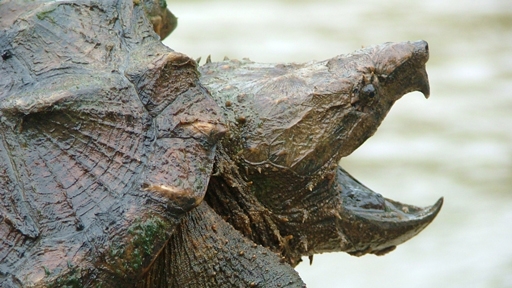
The fearsome alligator snapping turtle is a uniquely-adapted hunter best known for its powerful jaws and quick bite. They are endemic to the Southeastern region of the United States, where they muck around the muddy bottoms of rivers, lakes, and canals.
Though they are named for alligators because of their ridged shells, these prehistoric-looking creatures are often called the dinosaurs of the turtle world.
Sadly these creatures are often captured and sold as pets, but these facts should make you think twice about ever approaching them in the wild.

1. They’re huge!
Alligator snappers are among the largest and heaviest turtles in the world. Mature males are generally larger than females and typically weigh about 175 pounds. There have been a few recorded cases of turtles weighing more than 220 pounds, and although there hasn’t been sufficient proof, it’s said that a 400-pound specimen was caught in Kansas back in the 30s!

2. Their jaws are super strong.
Like other snapping turtles, alligator snappers have a forceful bite. Their jaws can crush through fish, fruit, broom handles and in rare cases, human fingers. Their bite force is about the same as humans, relative to their body size. The difference is they are extremely quick, and sharp beaks can do serious damage.

3. They aren’t the same as common snapping turtles.
In fact, their differences are quite visible. While common snapping turtles have smooth shells, alligator snapping turtles have raised spikes along their carapace (the top part of their shells) — much like alligators, after which they are named.

4. There are three known species.
For more than a century, researchers thought all alligator snapping turtles were a single species. However, a 2014 study found that there are actually three separate species: Macrochelys suwanniensis and Macrochelys apalachicolae, which are named after the Suwannee and Apalachicola rivers where they live and the long-known Macrochelys temminckii (most common in the Mobile and Mississippi rivers).
5. They have a genius ambush hunting trick.
The turtles hunt by opening their mouths wide while lying motionless in the water. The tip of their tongues has a red worm-like appendage that they move around like a fishing lure to attract prey. Once the prey gets close enough, their jaws snap shut with astonishing speed and force.

6. They’ll eat pretty much anything they can find.
Alligator snapping turtles are generally meat-eaters that hunt fish. But they’ll also make a quick meal of fish carcasses, plants, small amphibians like snakes and frogs, and sizeable mammals like raccoons. They’ve even been known to eat other turtles and small alligators!

7. They are masters of camouflage.
Alligator snapping turtles have developed special adaptations to make them blend in like a rock underwater. Their shells are often covered in algae, which helps them stay camouflaged in the muddy water while luring unsuspecting prey. Their eyes are also surrounded by excess skin covered in small spots, which make it harder to spot their pupils.
8. They rarely go on land.
While females will venture out of the water to lay their eggs, males typically spend their entire lives in water. In fact, these turtles can stay underwater for 40 to 50 minutes before they need to come up for air. Even then, it’s simply a matter of sticking their noses above the water for a few breaths before disappearing again.

9. They have no natural predators.
Alligator snappers are pretty much at the top of their food chain. Other than animals like raccoons or snakes who target their eggs, their biggest threat is, you guessed it: humans. The turtles have been hunted extensively for their meat or to be sold in the exotic pet trade.
In fact, they are listed as an endangered species in some states and as threatened by the International Union for Conservation of Nature and Natural Resources.
10. They live for a long time.
Alligator snapping turtles often live to be about 80 to 100 years old, though it’s possible they can live up to 200 years of age. Captive turtles have a much shorter lifespan of 20 to 70 years.
Check out the video for more:




